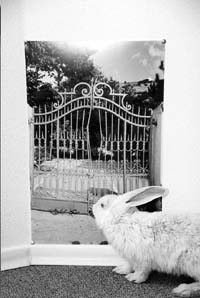New project at the Gelman Gallery in Kyiv

Blue is a very popular color in life and daily practices. Its utilitarian function is that of a purity certificate, also a sensation of vigor. Even faded blue makes one want to immediately revive it, the way one wants to quench one’s thirst. Tracing this pattern, Nataliya Filonenko worked out her main character: blue and its natural immensity in the sky. “To an extent this exhibit is kept in the romantic spirit of the 1960s; it’s a longing for that magic art where the sense of being is revealed not through intellect and impassioned discussions, but through sensuality. The works on display are kept in the spirit of minimalism and actionism, conceptual art and arte povera. No didactic information here, just natural rejuvenation and the subconscious method of encountering the world. Art is born of experimenting with life where the artist, as though he were an alchemist, is attracted by the simplest of natural objects, materials, or phenomena, by their physical and biological properties. The artist wants to create something unusual, magic, rediscover components of nature: water, flowers, his own body, forest, horses, and rabbits.”
The inner folkloristic specifics and originality of Zhanna Kadyrova’s Blue Horse and Blue Rabbits are charged with reality and the animals served as a charming performance at the opening ceremony. In the Tibetan religion of Bon the fifth element, “space,” an “all-penetrating dimension” is symbolized by the horse. Implying the active nature of that element. Once the horse races off the island and into the sea amidst the shining treasures of the King of Wishes, it can be saved only by a year-old child. The young artist lovingly made up for sky blue lacking in the white horse, turning it into a piece of jewelry fulfilling all your wishes. A video tape made before the opening of the exposition was meant as a separate artifact and will soon be put on display; for the champions of animal rights it will serve as a graphic evidence of man’s loving attitude. And the rabbits obviously felt better there than at the Kurenivka bazaar, showing a keen interest in the works of art.
Kseniya Hnylytska is a clear fancier of the sky blue element. In her Blue Series photo project emerges an instant contact between impressions and the innately rich blue in the components of the surrounding real world. By ingeniously choosing objects — metal gate, garbage can, or a graveyard cross — she achieves the most tangible effect of chalcedony, azure, “autumnal” blue, without which the viewer would never perceive the full scope of immaculate purity.
Yury Solomko’s Calm of the Depth and Altitude Scale series is a chart of one huge sea without boundaries or coastlines. The depth scale is rather dubious, making one wonder: maybe it is actually a comparison to the gray sky or maybe it is not a sea at all. Shining emptiness strives to penetrate even deeper into the deceptively calm sea and to achieve a matching expressiveness. Looking at this false calm, one feels one’s mood heighten until there is a physical sensation of the total absence of wrinkles — and effect cosmeticians attribute to blue clay.
Maksym Mamsykov proves that washing linen can be a fact of art. In his Grand Laundry video project we find a virtual still-life with blue chrysanthemums in an invisible vase, conveying vibrations from an invisible washing machine. The flowers tremble to set rhythm moving in and offscreen. If you accelerate the vibration by working up the spin dyer you can experience a different kind of delight.
Kyrylo Protsenko’s elegant mystification, Mountain Resort Medeo, consists of crystal clear air and white snow existing thanks to concrete blue shadows creating the mountainous volume. And the UFO above creates the illusion of space. A truly stimulating pictorial art.
Illia Chychkan’s multifigure composition, an imprint on paper of naked male bodies, using blue paint, has deeper historical roots than Yves Klein’s “blue period” who in the early 1960s experimented with female bodies the same way. The roots are in the scientific tests to study the Shroud of Turin that once kept mankind in suspense.
Nataliya Filonenko points out, “The fact that Ukrainian culture is still terra incognita and that the world doesn’t seem anxious to explore it is explained not so much by the quality of our art as by the political and economic situation in this country. Ukrainian art is not marginal or isolated; our artists are in the same situation, although entering it through the back door. Some gestures here look like naive discoveries, although in the West they would be interpreted as easily identifiable references to the 1960s.” However, Hlib Katchuk’s video To Kill Krishna appears quite rather sophisticated in the context of Blue Clay, with the tight idea being unjustifiably complicated.
Still, Kseniya Hnylytska’s fleeting remark at the opening ceremony, “It’s like a birthday in blue,” seems to most accurately convey the atmosphere of the exposition and viewers’ impressions, as the whole project is kept purely aesthetic and festive, dominated by the prototypes of sea and sky.






